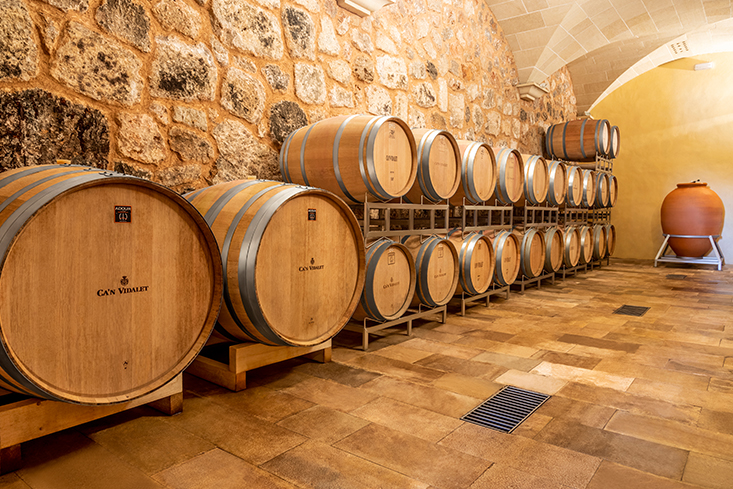Tasting a wine is like an authentic journey of emotions and sensations. A wine expresses to us its origin in the vineyard, its handling in the winery, even how it has been fermented; as well as the senses and perceptions of each one of us at the moment of taking the wine to our palates.
Different steps to wine tasting
The moment of uncorking a bottle of wine has arrived. We specify the tasting step by step and we talk about interpretation and meaning:
The tasting consists of 3 phases or stages:
- Visual phase – appearance
- Olfactory phase – nose
- Gustatory phase – taste
In the first step we look at the colour of the wine. The eye perceives the purity, colour and clarity of the wine. The colour gives us information about the age of the wine and the grape variety with which it was produced.
Our wines in Can Vidalet are young wines such as Blanc de Blancs and Blanc de Negres, as well as matured wines like Ses Pedres, So del Xiprer and Terra Fusca.
In the second step we smell the wine without swirling it in the glass. This way we identify the primary aromas, interpreting the variety of grape and the terrain of the vineyard.
Aromas according to the variety of the grapes at Can Vidalet:
White grape varieties
Chardonnay: Aroma of white fruits (green apple and pear), citrus (lemon, grapefruit), tropical fruits (pineapple and lychee), flowery and herbal.
With aging in oak: vanilla, honey and butter.
Sauvignon Blanc: Aroma of tropical fruits (melon), citrus, white flowers (orange blossom), herbaceous (herbs or freshly cut grass).
Prensal: Aroma of white fruits (apple, pear), tropical fruits (pineapple).
Moscatel: Aroma of stone fruits (apricot or peach), citrus (orange zest), white flowers (orange blossom) and when it is over ripe notes of figs and honey.
Red grape varieties
Cabernet Sauvignon: Red aromas (blackberry, raspberry, blackcurrant) and vegetable aromas (green pepper).
Pinot Noir: Aromas of black fruits (cherry), red fruits (raspberry, strawberry), blue flowers (violet).
Syrah: Aromas of red fruits (wild blackberry), black fruits (blackcurrant), vegetable aromas (pepper and laurel).
Merlot: Black fruit aromas (cherry and blackcurrant), red fruit (red berry jam), vegetable aromas (green pepper).
Callet: Aromas of red fruit (raspberry and red currant), black fruit (cherry and blackberry).
With aging we have empyreumatic (balsamic and roasted) aromas like toasted bread, coffee, cocoa, caramel and smoke.
After having identified the primary aromas in the glass, we gently swirl the wine and allow oxygen to combine with the wine. In this way, we extract the secondary and tertiary aromas, distinguishing the aromas that arise during the fermentation of the wine, these are the secondary ones.
The tertiary aromas are the hardest to identify as they occur as the wine ages.
The third and final step is our palate, the taste when the wine finally touches our tongue – we taste it with a small sip. This way we identify the different properties, going through 4 important elements.
First is the intensity; it is the power with which the aromas surprise us on the palate. It is distinguished in moderate, intense or very intense.
Second is the body; that refers to density and consistency of a wine.
Third is the harmony; the balance between all the components that are part of a wine.
Finally is the persistence; the duration of flavours on the palate.
Conclusion
To understand the process of tasting a wine works just as trying a plate of food, first we look at it, we smell it and finally we taste it. During the tasting of a wine exactly the same happens. The flavour of the wine has its origin in the variety of the grape, in the processing and even in the state of mind of each one of us. There are many different impressions, such as aroma, taste, colour nuances, memories and feelings, that are mixed in an explosion of emotions. It is our mind that must assign these perceptions in order to identify the colours by sight, the aromas by the nose and the flavors by the palate. We put “order” in the intensity of our senses to describe the wine we taste.
